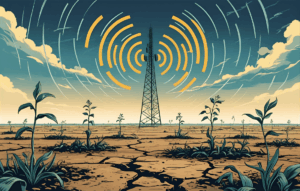While our world becomes increasingly interconnected through wireless technologies, a growing number of individuals report experiencing a range of adverse symptoms that they attribute to exposure to electromagnetic fields (EMF). Known most popularly as Electrohypersensitivity (EHS), this phenomenon is described by sufferers as severe enough to interfere with daily life, yet it remains a contentious issue within the medical and scientific communities.
Understanding Electrohypersensitivity (EHS)
EHS, sometimes referred to as “microwave syndrome,” is reported by its sufferers to cause a myriad of non-specific symptoms such as skin irritations, fatigue, heart palpitations, nausea, and cognitive disruptions when exposed to EMF emitted by devices like cell phones, Wi-Fi routers, and other electronic apparatus. Despite the increase in self-reported cases, EHS is not universally recognized as a medical diagnosis.
Prevalence
Estimates vary widely, but some suggest there are several hundred cases of EHS per million people, with about 10% of these cases being severe. The condition’s recognition varies by country, impacting how patients can seek help and receive accommodations.
Symptoms and Reports from Individuals
Those who identify with EHS report a broad spectrum of symptoms, which can include:
Skin reactions: Tingling, redness, and burning sensations.
Neurological disturbances: Fatigue, dizziness, and headaches.
Cardiac symptoms: Heart palpitations and irregular heartbeats.
Digestive issues: Nausea and discomfort.
Cognitive impairments: Difficulty concentrating and memory lapses.
Individual Accounts
Diverse personal accounts add to the complexity of EHS. For example, some sufferers report debilitating symptoms that prevent them from using basic modern technologies, while others manage by modifying their exposure and environment.
Impact of Electromagnetic Fields on Neurological Health: Insights from Environmental Research Study
As our understanding of Electrohypersensitivity (EHS) continues to evolve, new research provides crucial insights into the condition’s pathophysiology and its impact on neurological health. A pivotal study by Environmental Research titled “Why Electrohypersensitivity and Related Symptoms are Caused by Non-Ionizing Man-Made Electromagnetic Fields: An Overview and Medical Assessment,” sheds light on the biological underpinnings of EHS and its broader implications for public health.
Key Findings from the Study
1. EHS as a Recognized Neurological Disorder
Belpomme and Irigaray argue that EHS should be recognized as a legitimate neurological disorder. Their study presents compelling evidence that EHS is characterized by measurable pathophysiological changes in the body, contradicting the notion that it is a psychosomatic condition. These changes include inflammation, oxidative stress, and blood-brain barrier disruption, all of which are documented markers of neurological dysfunction.
2. Commonalities with Multiple Chemical Sensitivity (MCS)
The study also explores the relationship between EHS and Multiple Chemical Sensitivity (MCS). Both conditions share similar symptoms and biological markers, such as inflammation and oxidative stress, suggesting a common underlying mechanism. This overlap points to the possibility of EHS and MCS being part of a broader syndrome triggered by different environmental factors—EMFs in the case of EHS and chemicals in the case of MCS.
3. Refutation of the Nocebo Effect Hypothesis
One of the critical aspects of Belpomme and Irigaray’s research is their refutation of the nocebo effect hypothesis. This hypothesis posits that EHS symptoms arise purely from the belief that EMFs are harmful. However, the study presents evidence of objective biological changes in EHS patients, which cannot be explained by psychological factors alone. These findings underscore the reality of EHS as a physical health condition.
4. Diagnostic Criteria and Biomarkers
The researchers propose specific diagnostic criteria for EHS, utilizing molecular biomarkers and cerebral imaging techniques. These tools enable an objective diagnosis of EHS, helping to differentiate it from other conditions with similar symptoms. This approach is crucial for validating EHS as a distinct medical condition and improving patient care.
5. Urgent Call for Recognition and Action
Belpomme and Irigaray call on international health organizations, particularly the World Health Organization (WHO), to recognize EHS as a genuine health condition. They advocate for stricter regulations on EMF exposure, emphasizing that current limits do not adequately protect public health. The study highlights the need for immediate action to mitigate the health risks associated with EMFs.
Pathophysiological Mechanisms of EHS
1. Inflammation and Oxidative Stress
The study provides evidence that EMF exposure induces inflammation and oxidative stress in the body. These responses are commonly seen in various neurological and chronic diseases. Inflammation and oxidative stress can damage cells and tissues, leading to a range of health issues, including neurodegenerative diseases.
2. Blood-Brain Barrier Disruption
EMFs can compromise the integrity of the blood-brain barrier (BBB), a critical structure that protects the brain from harmful substances in the bloodstream. Increased permeability of the BBB allows toxins to enter the brain, potentially causing neurological damage and contributing to the symptoms experienced by EHS patients.
3. Neurotransmitter Abnormalities
EHS patients often exhibit abnormal levels of neurotransmitters, the chemical messengers in the brain that regulate mood, cognition, and other neurological functions. These abnormalities can disrupt normal brain function, leading to symptoms such as headaches, cognitive difficulties, and mood disturbances.
Electrohypersensitivity: Unpacking a New Neurological Disorder
In a study conducted by the International Journal of Molecular Science, EHS has been identified and characterized as a neurological disorder linked to electromagnetic fields (EMFs). This research highlights significant correlations between EHS and multiple chemical sensitivity (MCS), revealing a shared pathological mechanism.
Database Insights
Extensive Data: Since 2009, a database comprising over 2000 cases of EHS and multiple chemical sensitivity (MCS) has been developed.
Overlap with MCS: EHS is associated with MCS in 30% of cases, with MCS often preceding EHS in 37% of these instances.
Clinical and Biological Characteristics
Symptoms: EHS patients exhibit neurological symptoms such as headaches, tinnitus, dizziness, and cognitive impairments, which worsen with EMF exposure and improve with avoidance.
Inflammation and Autoimmune Response: EHS is marked by low-grade inflammation and an autoimmune response against O-myelin.
Oxidative Stress: 80% of EHS patients have detectable oxidative stress biomarkers in their blood.
Diagnostic Tools
Imaging Techniques: Ultrasonic cerebral tomosphygmography and transcranial Doppler ultrasonography reveal defects in middle cerebral artery hemodynamics, particularly in the capsulo-thalamic area of the temporal lobes. These findings suggest involvement of the limbic system and thalamus, confirming EHS as a neurologic disorder.
Biomarkers: Blood tests show increased levels of histamine, S100B protein, nitrotyrosine, and autoantibodies against O-myelin, supporting the diagnosis of EHS.
This study underscores the importance of recognizing EHS as a legitimate neurological disorder and highlights the need for global health authorities to implement protective measures against EMFs and environmental chemicals. By understanding the link between EHS and MCS, we can better diagnose, treat, and prevent these conditions, ultimately improving the quality of life for those affected.
Highlighting Mike Bender’s Journey with Electrohypersensitivity
In an enlightening piece featured on Aires Tech’s blog “The Wave,” Mike Bender, the founder of Awkward Family Photos, shares his profound journey battling electrohypersensitivity (EHS), a condition that turned his world upside down. Titled “Awkward Family Photos Founder Mike Bender’s Story of Electrohypersensitivity,” the article chronicles his initial struggles, his awakening to the real impacts of EMF, and ultimately, how he found relief through innovative technology.
Mike Bender’s story begins with an account of deteriorating health due to Lyme disease and mold exposure, which compromised his body’s ability to detoxify, setting the stage for severe hypersensitivity to electromagnetic fields. His symptoms escalated to a point where ordinary electronic devices caused him debilitating pain and discomfort.
The Awakening: Recognizing the Unseen Enemy
The turning point for Mike came when he realized that his symptoms were triggered by EMFs from everyday devices like cell phones and wireless modems. Despite initial skepticism from doctors and family, Mike’s condition forced him to recognize the pervasive impact of EMFs on his health. Through self-conducted experiments, he confirmed his acute sensitivity to EMF, which was initially dismissed by many around him as psychological.
Living with Electrohypersensitivity
Mike’s narrative vividly describes living with EHS as a constant battle, comparing his symptoms to a “whistling teapot coming to a boil.” His daily life became a series of acute reactions—pounding migraines, panic attacks, and an overarching sense of fight-or-flight triggered by EMF exposure.
Seeking Sanctuary: The Quest for a Quiet House
Determined to find a solution, Mike moved to a specially renovated home designed to minimize EMF exposure. His quest for a “Quiet House” was both a personal journey and a public case study documented extensively, offering hope and guidance to others experiencing similar challenges.
A Glimmer of Hope: Unveiling the Path to Resolution
The breakthrough came when Mike discovered Aires Tech, a company specializing in EMF modulation technology. Intrigued by their innovative approach to EMF mitigation, Mike was particularly drawn to the fact that their devices reorganized rather than blocked EMF radiation, which could often exacerbate symptoms by making devices increase their output.
Relief from Electrohypersensitivity with Aires Tech Devices
Mike’s testimonials about Aires Tech’s Lifetune devices (save 25% off with code “kyletothemoon”) paint a picture of transformation. The Lifetune One device, when attached to his phone, allowed him to use it without triggering his hypersensitivity. This newfound freedom marked a significant turning point in his life, reducing his symptoms and allowing him to engage with technology on his terms.
EMFs, Electrohypersensitivity, and Neurological Disorders: A Growing Crisis
In my recent blog post, Global Burden of Nervous System Disorders Revealed, I explored the alarming rise in neurological conditions worldwide. This growing crisis has significant implications for understanding electrohypersensitivity (EHS) and its impact on our health.
Key Findings
Widespread Impact: Over 3.4 billion people, or 43% of the global population, were affected by neurological conditions in 2021.
Top Conditions: Stroke, neonatal encephalopathy, migraines, Alzheimer’s, and diabetic neuropathy are major contributors to this health crisis.
Rising Numbers: The total DALYs for nervous system disorders reached over 443 million in 2021, an 18% increase since 1990.
Understanding the CNS and EMFs
The central nervous system (CNS) operates through a complex network of neurons that transmit information via electrical and chemical signals. This intricate system manages everything from reflex actions to complex cognitive functions. However, the increasing prevalence of EMFs from electronic devices poses new challenges.
Impact of EMFs on the Nervous System
Electromagnetic fields (EMFs) can have several adverse effects on the CNS, contributing to the rise in neurological disorders:
Cellular Stress: EMFs can generate reactive oxygen species (ROS), potentially leading to neurodegenerative diseases.
Blood-Brain Barrier Disruption: EMFs may increase BBB permeability, allowing harmful substances into the brain.
Neurotransmitter Disruption: EMFs can interfere with brain neurotransmitters, affecting mood and cognitive functions.
The Link to Electrohypersensitivity
Research has shown that EHS is a real, neurologically characterized condition with measurable pathophysiological changes. The study, “Why Electrohypersensitivity and Related Symptoms are Caused by Non-Ionizing Man-Made Electromagnetic Fields,” provides critical insights into how EMFs can disrupt the CNS, leading to symptoms similar to those seen in other neurological disorders.
In one notable study, Danish utility workers exposed to higher EMF levels showed increased risks for neurological diseases like senile dementia and motor neuron diseases. This underscores the potential for EMF exposure to contribute to broader neurological health issues, including EHS.
For a more in-depth look at these findings and their implications, check out my detailed post: Global Burden of Nervous System Disorders Revealed. Understanding the connection between EMFs, EHS, and neurological disorders is crucial for advocating better public health measures and protecting our nervous system health.
The One Name Project: A Call for Unity and Recognition
In response to the fragmented understanding and recognition of EHS and related conditions, the One Name Project was launched. This initiative seeks to unify the terminology related to EMF-related illnesses to streamline research, treatment, and advocacy efforts.
Goals of the One Name Project
The primary goal of the One Name Project is to establish a single, universally recognized term that encompasses all EMF-related health issues. This effort is driven by the need for clearer communication among scientists, medical professionals, and the public. A unified term could enhance the visibility of the condition, improving funding opportunities for research and leading to better patient care.
Challenges and Resistance
The project faces significant challenges, including resistance from industries benefiting from unregulated advancements in technology. Additionally, there is a general lack of public awareness and understanding regarding EMF-related health issues, which complicates advocacy efforts.
Future Implications
If successful, the One Name Project could pave the way for more standardized diagnostic criteria and better therapeutic approaches, making a significant difference in the lives of those affected by these conditions. More importantly, it could lead to greater recognition of EHS within the medical community and broader public, fostering a more inclusive approach to those experiencing these debilitating symptoms.
Diagnosis and Management of EHS
Challenges in Diagnosis
Diagnosing EHS is challenging as there is no consensus on criteria and no objective tests that can definitively link symptoms to EMF exposure. This leads to a reliance on self-reported symptoms and personal histories, complicating the clinical approach to treatment and management.
Management Strategies
Management of EHS typically involves:
- EMF avoidance: Limiting exposure to known sources of EMF.
- Environmental modifications: Using scientifically validated EMF-protection products.
- Behavioral therapy: Engaging in cognitive-behavioral therapy to manage symptoms.
- Lifestyle changes: Improving overall health to bolster resilience against symptoms. This is going to be most important for all humans dealing with various genetic weaknesses or disorders, which is why we must adopt a rigorous lifestyle overhaul if we want to truly get better and thrive.
Legal and Social Dimensions
The lack of formal recognition affects EHS sufferers’ ability to receive accommodations or recognition in disability frameworks. Countries like Sweden and France have made strides in recognizing and accommodating EHS, but many other nations lag, creating a patchwork of support that greatly depends on geographical location. It doesn’t quite fit the memo yet, which is why I always recommend putting your health into your own hands.
Scientific Skepticism and Research
The scientific community remains largely skeptical of EHS, citing a lack of clear, reproducible evidence linking EMF exposure to the reported symptoms. Research often points to the nocebo effect, where individuals develop symptoms because they believe they are being harmed by EMFs, rather than the EMFs themselves causing harm.
Theories of Sensitivity
Some researchers, however, suggest that certain individuals might possess a unique sensitivity to electromagnetic fields, possibly due to genetic factors or pre-existing health conditions. This hypothesis remains under investigation, to understand why some people might react adversely to electromagnetic exposures that most people can tolerate.
My personal opinion? I believe EHS is a very real thing. I know from the studies that we do have, that electromagnetic field radiation will exacerbate an existing weakness in the bodily systems. This can lead to many other flare-ups, chain reactions, and diseases within the body. I have spent hours discussing this with Mike and others who suffer from EHS.
Conclusion
Electrohypersensitivity remains a complex and controversial issue. While skepticism exists, the distress reported by individuals cannot be dismissed outright. The growing dependency on wireless technology calls for a balanced approach that considers the health of all individuals. Through initiatives like the One Name Project, there is hope for a future where the voices of those affected by EHS are heard and addressed, leading to a healthier, more inclusive society.













